
Medical Waste Incineration
A lot has been said and written about medical waste and its disposal methods particularly medical waste incineration. The arguments, for and against, have been going on since the early 1990s. There have been guidelines and notifications from government regulatory authorities from time to time. Workshops and seminars were conducted by Indian Medical Associations and NGOs throughout the country to highlight the importance of proper disposal of medical waste as untreated or improper medical waste could lead to serious infection, spread of diseases and misuse of disposables.
These happenings created quite a stir and brought about greater awareness among the generators of these wastes of the need to:
• Segregate wastes using colour coded bags
• Identify various disposal options available
• Make sure these wastes do not find their way to secondary markets
• Train housekeeping and other staff regularly
It became necessary to be aware of the different categories of wastes and how to dispose them effectively. There were some medical wastes which could only be incinerated and these included pathological wastes and there were others such as sharps and plastics which are to be autoclaved and so on.
There was also a time, in the interim, when the regulatory authority issued notifications for individual hospitals to set up their own disposal facilities. Many hospitals went about doing this. The first standards included some guidelines for an incinerator and an autoclave and these were made more stringent in the years to come.
Haat supplied quite a number of medical waste incinerators to this sector in India and abroad. Of particular interest was the State of Kerala, where we came to know there were more than 4000 hospitals, big and small. Kerala being a very small state, this was an astonishing statistic, but considering the literacy rate and hence awareness, this was not surprising.
Many major hospital groups in India and abroad opted to go in for Haat’s medical incinerator range and so also the Defence hospitals.
The rules underwent further changes whereby only remotely located hospitals or large ones were allowed to set up their own captive incinerator facilities and others were asked to hand over their waste to common medical waste incinerator facilities set up in each city and town. This step was taken to reduce proliferation of poorly designed incinerators.
In either case, hospitals continued to opt for Haat incinerators and even common biomedical facilities chose these units.
We had requests from the earthquake affected Kutch region of Gujarat, remote hospitals for Adivasis in Bihar and in the north east, many missionary hospitals from all over the country, in particular from Kerala, and Haat’s medical waste incinerators were supplied, installed and commissioned in most places.
What was amazing to see from our interaction with the healthcare sector was the presence of Keralite nurses in practically every hospital. We do not know why only Keralites chose this profession but it shows their magnanimity to do service to the sick, which is commendable.
The healthcare industry is now able to dispose of its infectious waste properly and safely and that is what matters to the general public. Haat’s experience with medical waste incinerators is unparalleled.


